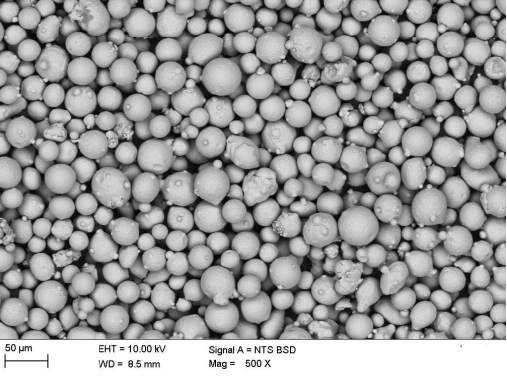Knowde Enhanced TDS
Identification & Functionality
- Technologies
- Chemical Composition
Depending on the use conditions, stricter analysis limits apply to certain alloy elements.
Features & Benefits
- Labeling Claims
- Base Chemicals Features
- Features
VDM® Powder 738LC is characterized by:
- spherical particles with low level of satellites
- high purity and reproducibility level
- low oxygen content
- small amount of porosity
- good flowability
- high apparent and tap density
Applications & Uses
- Markets
- Applicable Processes
- Applications
VDM® Powder 738LC can be used for a wide range of processes:
- Laser based additive manufacturing
- Electron beam based additive manufacturing
- Coatings
- Direct energy deposition
- Overlay welding
- Cold and hot isostatic pressing (CIP / HIP)
VDM® Powder 738LC can be used for many demanding applications. Originally, it was developed and used for static and rotating components in aircraft turbines such as housings, mounting elements and turbine blades and vanes because of the excellent oxidation resistance.
Properties
- Chemical Properties
- Physical Properties
- Physical Properties
Particle size distribution
μmFlowability Apparent density Tap density ASTM B213 ASTM B964 ASTM B212 ASTM B417 ASTM B527 15-53 Y Y Y Y Y Y - The test can be performed
Standard inspection certificate contains particle size distribution and chemical analysis.
- Microstructural Properties
VDM® Powder 738LC microstructure consists primarily out of a γ-phase matrix and the γ′ intermetallic phase of the form Ni3Al. The solid solution elements present are chromium, cobalt, tungsten and tantalum; these equally contribute to the structural stability of the alloy. Carbides and borides form the main grain boundary strengtheners.

| Value | Units | Test Method / Conditions | |
| Aluminum Content | 3.20 - 3.70 | wt. % | - |
| Boron Content | 0.007 - 0.012 | wt. % | - |
| Carbon Content | 0.09 - 0.13 | wt. % | - |
| Cobalt Content | 3.00 - 9.00 | wt. % | - |
| Chromium Content | 15.70 - 16.30 | wt. % | - |
| Iron Content | max. 0.10 | wt. % | - |
| Manganese Content | max. 0.02 | wt. % | - |
| Molybdenum Content | 1.50 - 2.00 | wt. % | - |
| Nitrogen Content | max. 0.02 | wt. % | - |
| Niobium Content | 0.60 - 1.10 | wt. % | - |
| Oxygen Content | max. 0.03 | wt. % | - |
| Sulfur Content | max. 0.015 | wt. % | - |
| Silicon Content | max. 0.30 | wt. % | - |
| Tantalum Content | 1.50 - 2.00 | wt. % | - |
| Titanium Content | 3.20 - 3.70 | wt. % | - |
| Tungsten Content | 2.40 - 2.80 | wt. % | - |
| Zirconium Content | 0.01 - 0.08 | wt. % | - |
| Value | Units | Test Method / Conditions | |
| Density (20°C) | max. 8.11 | g/cm³ | - |
| Melting Range | 1230 - 1315 | °C | - |
Regulatory & Compliance
- Designations and Standards
Standard Material designation
SAE AMS 5410 C* *only chemical analysis except Zr.
Packaging & Availability
- Availability
According to the requirements of the powder based processes, VDM® Powder 738LC is available in a wide range of particle fractions from 15 to 250 μm. The typical powder atomization yield ranges from 0.1 to 300 μm. After atomization, the powder is sieved and air classified according to customers specifications. All production and handling operations are carried out under protective atmosphere (argon).
Standard particle fractions
Particle size distribution
[μm]Fine particle D10
[μm]
(tolerance +/-5 μm)D50
[μm]
(tolerance +/-5 μm)15-53 <15 μm max. 3% 22 35 The determination of the PSD is done by laser diffraction according to ASTM B822.
- Packaging
The whole production and packaging process at VDM Metals is under argon and the powder has no contact to atmos-phere. The standard powder is packed in plastic bags (5 kg/10 kg/20 kg) under argon inside of sealed plastic drums (6l).
Storage & Handling
- Handling
- Please note that powder transportation may result in segregation of particle sizes.
- Do not open the container in humid environment.
- After contact with air the powder has limited storability.
- Humidity can influence the powder properties.

